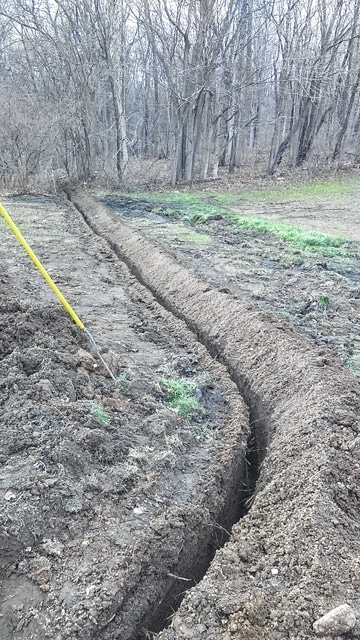
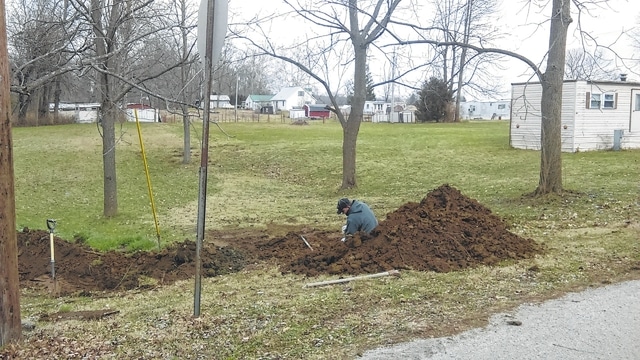
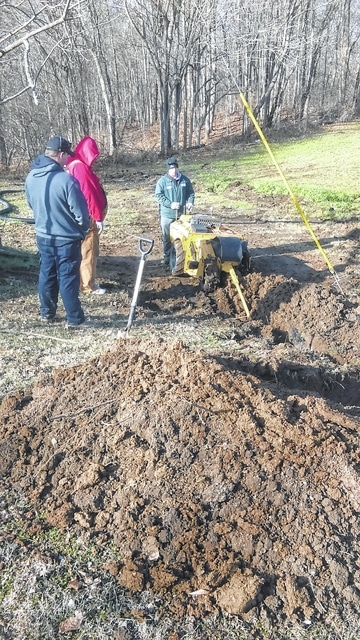
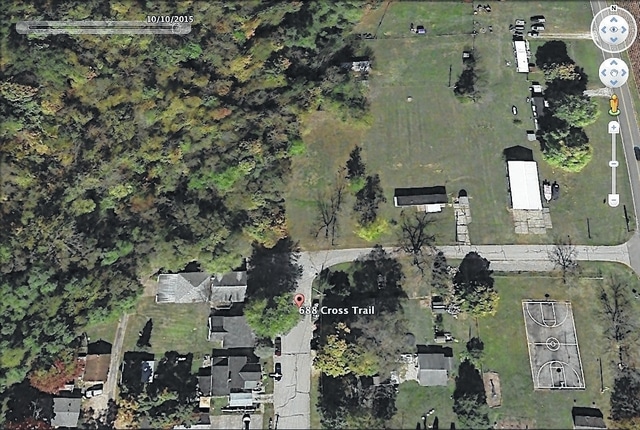
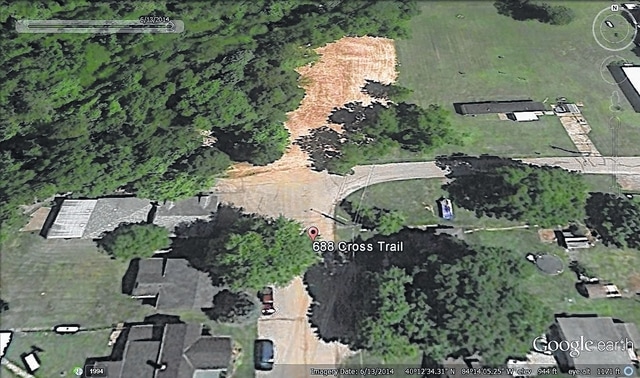
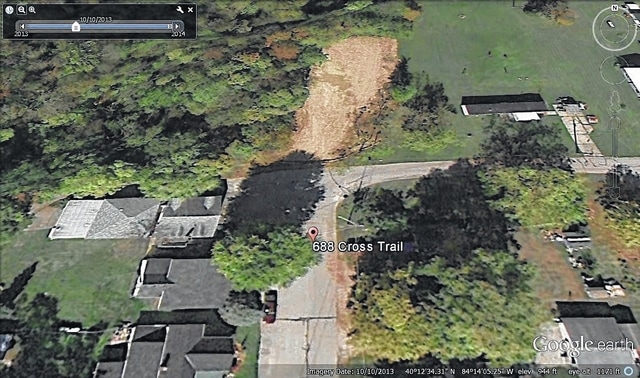
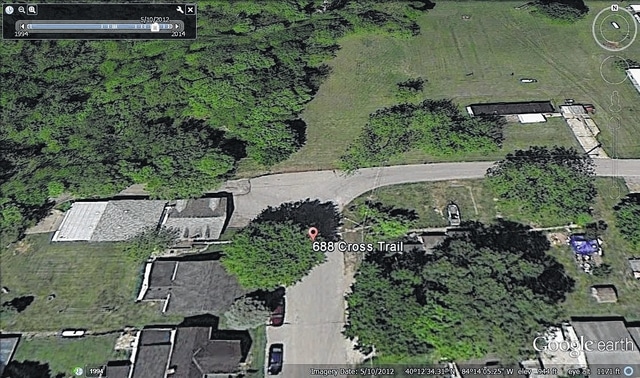
LOCKINGTON — What started out as a project to revitalize a community, soon turned into confusion and a battle for someone to take blame.
Stacy Nash, 688 Cross Trail, alleges the Lockington Locks Project caused significant damage to her home’s sewage system.
During phase 1 of the renovation of lock 1, from June 2013 to mid-2014, the renovators took dirt from the project and stored it in an open field adjacent to her home. There were dump trucks that drove in and out of the field loading and unloading the dirt.
“During the same time, we began to have issues with the draining of our septic system. We had someone come in and use a bobcat to install an outlet for the drain. We rented an eel twice running it through our line thinking maybe it was clogged up. We have had the septic drained twice in the last year due to the liquid backup. We are also on our third motor for the aeration system due to the backed up water burning out the motors,” she said. “Soon we saw liquid bubbling up in the grassy area across the street from our house (in that open field).”
When Nash connected that these issues could have been caused by the dirt and machines, she reached out to the people responsible for the renovation process, including representatives from Ohio History Connection (OHC), The Ohio Department of Transportation (ODOT) and The Spieker Company, the contractors that worked on the project.
These entities said they couldn’t do much to help her though, because first, the cause of the sewage issues was not definitively determined, and second, the open field didn’t belong to the Nash family or the project; it belonged to a neighbor.
Fred Smith, owners representative for the Lockington Project, and manager of architectural services for Ohio History Connection, said it was very hard to determine a cause of the issues. Smith, who hired the engineers and managed the funding for the project, said they wanted to help her, but it was very hard to find fault.
In an email to Nash, dated Nov. 2, Smith said, “The Spieker Company was looking for a place to put the dirt and Mr. Gilmore (the neighbor) let them put it over your sewer. In other words, OHC and ODOT had no control over what happened to your sewer and are not a party to this dispute. All of this occurred outside the project limits and off state property.”
“All we could really do was advise her. … We have a responsibility with public money. … We needed absolute proof before we could help her,” Smith said.
He said, neither OHC or ODOT had leverage to force the neighbor or the contractor (or anyone) to pay for the costs to repair her sewage system.
“One of the biggest (items of proof) to me is the fact that in the vendor inspection documents, there is an invoice for service stating that there is no water flowing from the unit and that is dated October 2014, lining right up with the Google Earth photos of the dirt mound and the project time line,” Nash said.
She also added that the pipe used to drain the water from the road in to the field, 4-inch black corrugated tubing, is different than the solid PVC piping under the road. This is because the pipe under the road needs to be strong enough to be driven over.
“The sheer weight of the loaded truck is more than enough weight to crush that plastic pipe … let alone the weight of the loads and loads of dirt that they stored on there,” Nash said.
Rusty Schwepe, an employee for the Sidney-Shelby County Health Department, was made aware of this case in July 2015.
“We are sent out to inspect all the (sewage systems) in the county. There are about 800 of them. We do it on a schedule,” he said.
According to the inspection document, dated July, 2, 2015, at that time, the motor for 688 Cross Trail’s aeration was not working properly, the time clock was not operating and there were issues with final effluent septic.
“System not functioning. Please have serviced by registered service provider,” the inspection document said. When Schwepe followed up later in July, the same comments were made on the inspection document.
The next time it was followed up on, Aug. 3, 2015, the system was still not functioning and Schwepe noted an administrative hearing would be scheduled.
By mid-September there was still untreated sewage surfacing in the field.
“She was working to find someone to help her. She was concerned there was damage. But in that immediate time it was her responsibility to get it fixed,” Schwepe said. “It was a matter of public health. Raw untreated-sewage surfacing like that could make animals and people living in the area sick.”
On Nov. 18, Nash finally set up an in-person meeting with a representative from the Spieker Company, Schwepe, and a representative from ODOT. At about this same time, Schwepe, with guidance from the Shelby County Soil and Water District determined it needed to be repaired by Jan. 4 or the property would be condemned.
Nash said, the meeting took place and we got nowhere. In the end they told me to repair it and then to “do what I had to do” as far as recovering the costs. “No matter what way you cut it … we were forced to fix an issue we didn’t cause or be kicked out of our home on the 4th,” she said.
“Ultimately condemning a property means that no one would be living there, meaning no water would be pushed into the system from using the sink or flushing the toilet, leading to less of a public health nuisance,” Schwepe said.
On the weekend of Jan. 2-3, 2016, Nash, her husband and several family members worked to dig a new trench in the field and fix the drainage problems. They paid for all of this out of their own pockets.
“We only had use of a large machine to dig for a few hours so we focused on finding the pipe while we had it. We would have had to have that machine for a longer period of time to dig up all the old pipe. Once we found it, we tied into the existing non-damaged pipe … rented a trencher and dug the trench and buried the new pipe. We used the same pipe as what was there as it was specified by the health department,” Nash said.
Schwepe said they stopped down there that week and everything looked good as far as drainage. There were still a few minor things to fix, like the timer on the pump. Ultimately, 688 Cross Trail was not condemned.
Nash may have saved her house, but recovering the costs to do so are posing impossible.
“I did seek out legal advice. I have been advised that in order to recover our costs, I would have to file a lawsuit against my neighbors and they in turn could recover their costs from the responsible party. That’s just not an option for us though. The Gilmores (Tootie and Junior) are our 85-year-old neighbors who are recovering from major health issues. They didn’t cause this mess. I have lived in this little village for almost 30 years. This is the only home my children have ever known. My husband and I work very hard to support our family and to keep a roof over our heads. We make an honest living and we’re honest people. We would never ask for anything more than what was right. Everyone involved knew that they crushed my pipe, in fact we have an email where they flat out admit it. However … no one involved was willing to step up, take responsibility and fix it. So we fixed it, and we will eat the costs to spare our neighbors,” she said.
She continued, “This village is not filled with wealthy people. They came in and spent all of that money (a little more than $2.4 million) to restore the lock when the historical town is falling down all around it. There are historical homes that have been abandoned and just sit there rotting. … The whole thing doesn’t make much sense to me. I will have a thing or two to say when phase two and three of this project come around and I hope that this raises concern in my neighbors the next time. This could all have easily happened to one of them.”








